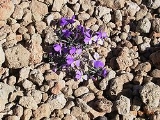
Viola cheiranthifolia
Encyclopedia
Viola cheiranthifolia is a species of the genus Viola
. It is also known as the Teide Violet and Teide Daisy.
This plant is exclusively found in the dry and stony caldera of the volcano Teide
on the Canary Island
of Tenerife
. It survives there in altitudes of 2000-3000m. Most of the time it is hiding under the rocks. It is only visible for three weeks in spring, when it comes out to the surface for pollination
.
It reaches heights of 6 to 7 inches.
Violet (plant)
Viola is a genus of flowering plants in the violet family Violaceae, with around 400–500 species distributed around the world. Most species are found in the temperate Northern Hemisphere; however, viola species are also found in widely divergent areas such as Hawaii, Australasia, and the Andes in...
. It is also known as the Teide Violet and Teide Daisy.
This plant is exclusively found in the dry and stony caldera of the volcano Teide
Teide
Mount Teide , is a volcano on Tenerife, Canary Islands. Its summit is the highest point in Spain, the highest point above sea level in the islands of the Atlantic, and it is the third highest volcano in the world measured from its base on the ocean floor, after Mauna Loa and Mauna Kea located in...
on the Canary Island
Canary Islands
The Canary Islands , also known as the Canaries , is a Spanish archipelago located just off the northwest coast of mainland Africa, 100 km west of the border between Morocco and the Western Sahara. The Canaries are a Spanish autonomous community and an outermost region of the European Union...
of Tenerife
Tenerife
Tenerife is the largest and most populous island of the seven Canary Islands, it is also the most populated island of Spain, with a land area of 2,034.38 km² and 906,854 inhabitants, 43% of the total population of the Canary Islands. About five million tourists visit Tenerife each year, the...
. It survives there in altitudes of 2000-3000m. Most of the time it is hiding under the rocks. It is only visible for three weeks in spring, when it comes out to the surface for pollination
Pollination
Pollination is the process by which pollen is transferred in plants, thereby enabling fertilisation and sexual reproduction. Pollen grains transport the male gametes to where the female gamete are contained within the carpel; in gymnosperms the pollen is directly applied to the ovule itself...
.
It reaches heights of 6 to 7 inches.

